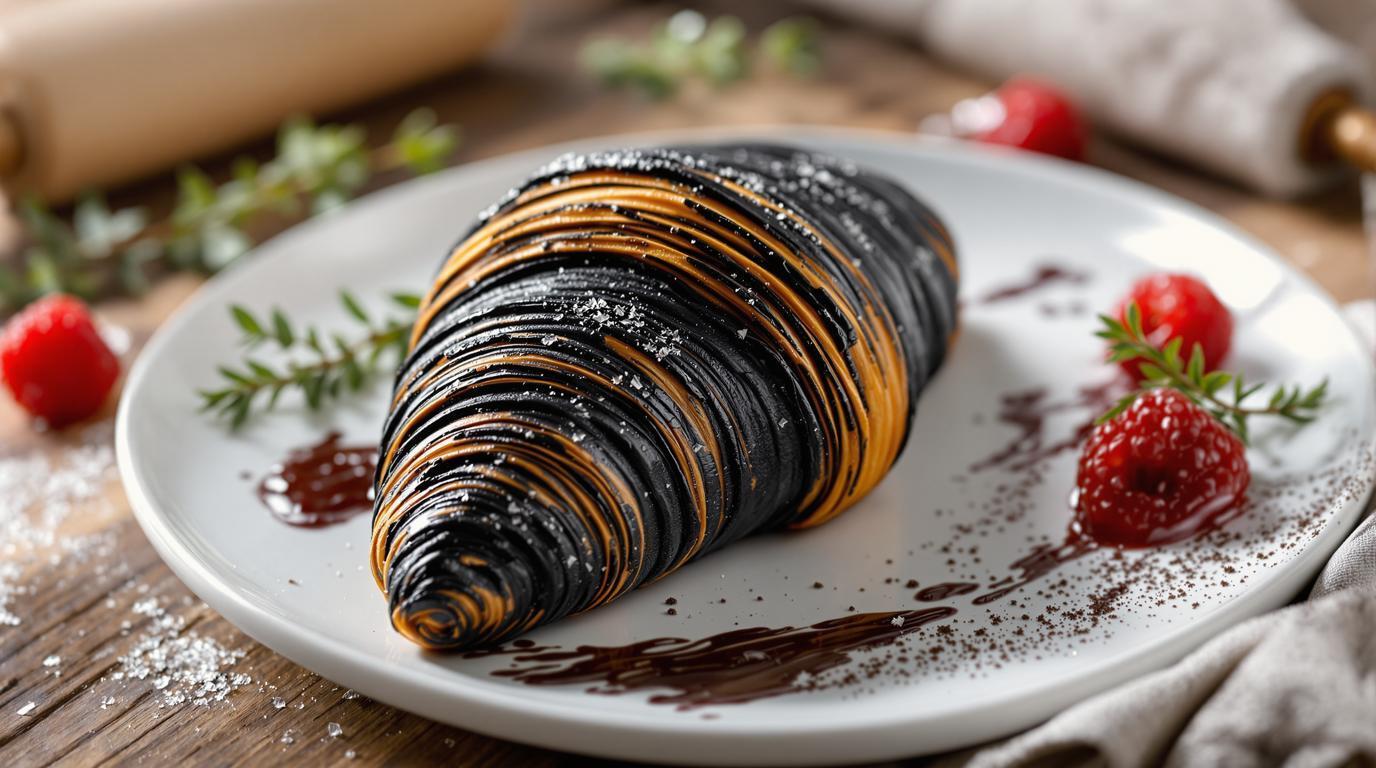The first time I created charcoal croissants in my Bangkok pop-up kitchen, guests literally gasped when I brought them out. That striking obsidian color against flaky golden edges creates an irresistible visual drama that traditional pastries can’t match. While classic croissants have centuries of French history, this contemporary twist emerged during the mid-2010s “black food” trend. What surprises most people is that beyond the Instagram-worthy appearance, the activated charcoal adds a subtle earthy depth that transforms the buttery layers into something mysteriously complex. The aroma remains traditionally inviting – warm butter and yeast – but the flavor experience becomes something entirely new.
The Story 📖
Charcoal croissants represent what I love most about modern cuisine – respecting tradition while fearlessly innovating. During my time working in Paris, I watched traditional boulangeries initially scoff at these black beauties before eventually embracing them. What makes these special isn’t just their dramatic appearance but how the subtle minerality of food-grade activated charcoal creates an unexpected counterpoint to the buttery richness of a classic croissant. The technique remains rooted in traditional French pastry craft – the crucial lamination process that creates those distinctive layers – but with a contemporary twist that captivates both the eye and palate.
Ingredients Spotlight 🧪
The soul of any croissant lies in quality butter. I recommend using European-style butter (82% fat content) for superior lamination. The activated charcoal powder (15-20g or 1-2 tablespoons) should be food-grade, preferably derived from coconut shells for a cleaner flavor profile. For optimal results, you’ll need:
- 500g (4 cups) all-purpose flour
- 225g (1 cup) cold unsalted European-style butter for lamination
- 40g (3 tablespoons) soft unsalted butter for dough
- 140ml (½ cup + 2 tablespoons) cold whole milk
- 55g (¼ cup) granulated sugar
- 12g (2 teaspoons) salt
- 11g (1 tablespoon) instant yeast
- 15-20g (1-2 tablespoons) food-grade activated charcoal powder
- 1 large egg (for egg wash)
Step-by-Step Guide 📝
This is a two-day process that yields 12 stunning croissants:
Day 1: The Dough Foundation
- Thoroughly mix all dry ingredients including charcoal powder before adding wet components. This ensures even color distribution without overworking the dough.
- Add cold milk and soft butter, mixing until a shaggy dough forms.
- Knead for 3-5 minutes until smooth but still slightly tacky.
- Shape into a disc, wrap tightly, and refrigerate overnight (at least 8 hours).
Day 2: Lamination & Baking
- Shape cold butter into a 5×6.5-inch rectangle between parchment paper.
- Roll chilled dough to 16×10 inches, place butter block in center, fold dough edges over butter like sealing an envelope.
- Execute a double fold: roll to 18×8 inches, fold into thirds, wrap and chill 30 minutes.
- Complete a single fold: roll again, fold into thirds, chill another 30 minutes.
- Roll dough to 3.5mm thickness, cut into triangles (9cm base), roll into croissants.
- Proof at room temperature (75°F/24°C) for 1.5-2 hours until visibly puffy.
- Brush with egg wash, bake at 375°F (190°C) for 15-18 minutes until edges turn golden.
Expert Techniques 🛠️
The key to exceptional charcoal croissants lies in temperature control. I keep my butter at exactly 59°F (15°C) – pliable enough to roll without breaking but cold enough to maintain distinct layers. When incorporating charcoal, mix it thoroughly with dry ingredients before adding any liquid to prevent streaking. During lamination, maintain sharp edges on your dough rectangle; sloppy edges lead to uneven layers.
Chef’s Note: The visual drama happens in the final proof and bake. The contrast between the matte black exterior and the glistening egg-washed edges creates the signature look. For maximum effect, brush egg wash only on the tips and edges of the croissants, allowing the charcoal’s deep black to remain the dominant visual.
Presentation & Pairing Ideas 🍽️
The dramatic appearance of charcoal croissants calls for thoughtful presentation. I love serving them on stark white plates with colorful accompaniments that pop against the black pastry. For sweet applications, try blackcurrant jam or bright raspberry compote. For savory versions, nothing beats the contrast of creamy goat cheese with beet-cured salmon and fresh herbs. These pastries pair brilliantly with rich dishes like beef bourguignon or can transform a breakfast burrito experience with their dramatic appearance.
For a quick dessert transformation, split and fill them with chocolate ganache – the combination creates a striking modern take on pain au chocolat that’s particularly stunning alongside a bright raspberry sorbet. During summer months, these make exceptional sandwiches for Mediterranean pasta salad accompaniments.
Remember, cooking is about making something your own. Try incorporating a teaspoon of espresso powder with the charcoal for deeper complexity, or finish your charcoal croissants with black sesame seeds for added texture. The canvas may be black, but the possibilities are endlessly colorful – just like the most exciting journeys in the kitchen always are!
